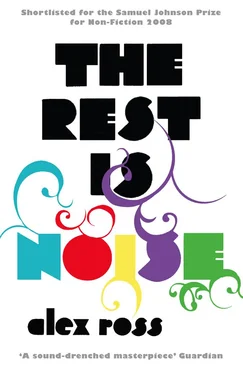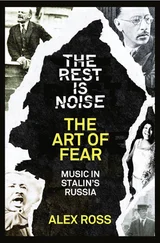The scene superficially resembled Schoenberg’s “scandal concert,” which shook up Vienna in March of the same year. But the bedlam on the avenue Montaigne was a typical Parisian affair, of a kind that took place once or twice a year; Nijinsky’s orgasmic Prelude to “The Afternoon of a Faun” had caused similar trouble the previous season. Soon enough, Parisian listeners realized that the language of the Rite was not so unfamiliar; it teemed with plainspoken folk-song melodies, common chords in sparring layers, syncopations of irresistible potency. In a matter of days, confusion turned into pleasure, boos into bravos. Even at the first performance, Stravinsky, Nijinsky, and the dancers had to bow four or five times for the benefit of the applauding faction. Subsequent performances were packed, and at each one the opposition dwindled. At the second, there was noise only during the latter part of the ballet; at the third, “vigorous applause” and little protest. At a concert performance of the Rite one year later, “unprecedented exaltation” and a “fever of adoration” swept over the crowd, and admirers mobbed Stravinsky in the street afterward, in a riot of delight.
The Rite, whose first part ends with a stampede for full orchestra titled “Dance of the Earth,” prophesied a new type of popular art—lowdown yet sophisticated, smartly savage, style and muscle intertwined.
It epitomized the “second avant-garde” in classical composition, the post-Debussy strain that sought to drag the art out of Faustian “novel spheres” and into the physical world. For much of the nineteenth century, music had been a theater of the mind; now composers would create a music of the body. Melodies would follow the patterns of speech; rhythms would match the energy of dance; musical forms would be more concise and clear; sonorities would have the hardness of life as it is really lived.
A phalanx of European composers—Stravinsky in Russia, Béla Bartók in Hungary, Leoš Janáček in what would become the Czech Republic, Maurice Ravel in France, and Manuel de Falla in Spain, to name some of the principals—devoted themselves to folk song and other musical remnants of a pre-urban life, trying to cast off the refinements of the city dweller. “Our slender bodies cannot hide in clothing,” goes the text of Bartók’s Cantata profana, a fable of savage boys who turn into stags. “We must drink our fill not from your silver goblets but from cool mountain springs.”
Above all, composers from the Romance and Slavonic nations—France, Spain, Italy, Russia, and the countries of Eastern Europe—strained to cast off the German influence. For a hundred years or more, masters from Austria and Germany had been marching music into remote regions of harmony and form. Their progress ran parallel to Germany’s gestation as a nation-state and its rise as a world power. The Franco-Prussian War of 1870–71 sounded the alarm among other European nations that the new German empire intended to be more than a major player on the international stage—that it had designs of supremacy. So Debussy and Satie began to seek a way out of the hulking fortresses of Beethovenian symphonism and Wagnerian opera.
But the real break came with the First World War. Even before it was over, Satie and various young Parisians renounced fin-de-siècle solemnity and appropriated music-hall tunes, ragtime, and jazz; they also partook of the noisemaking spirit of Dada, which had enlivened Zurich during the war. Their earthiness was urban, not rural—frivolity with a militant edge. Later, in the twenties, Paris-centered composers, Stravinsky included, turned toward pre-Romantic forms;
the past served as another kind of folklore. Whether the model was Transylvanian folk melody, hot jazz, or the arias of Pergolesi, Teutonism was the common enemy. Music became war carried on by other means.
In Search of the Real: Janáček, Bartók, Ravel
Van Gogh, in his garden at Arles, was haunted by the idea that the conventions of painting prevented him from seizing the reality before him. He had tried abstraction, he wrote to Émile Bernard, but had run up against a wall. Now he was fighting to put the brute facts of nature on canvas, to get the olive trees right, the colors of the soil and the sky. “The great thing,” he declared, “is to gather new vigor in reality, without any preconceived plan or Parisian prejudice.” This was the essence of naturalism in late-nineteenth-and early-twentieth-century art. It surfaced in works as various as Monet’s transcendent visions of train stations and bales of hay, Cézanne’s hyper-vivid still lifes, and Gauguin’s steamy visions of Tahiti. It animated various other contemporaneous cultural phenomena, such as Zola’s novels of miners and prostitutes, Maxim Gorky’s exacting portraits of peasant life, and Isadora Duncan’s free, anti formal dancing. In whatever medium, artists worked to dispel artifice and convey the materiality of things.
What would it mean for music to render life “just as it is,” in van Gogh’s phrase? Composers had been pondering that question for centuries, and, at various times and in different ways, they had infused their work with the rhythms of everyday life. The Enlightenment philosopher Johann Gottfried von Herder had proposed that composers find inspiration in Volkslieder, or folk songs—a phrase he coined. Countless nineteenth-century composers installed folkish themes in symphonic and operatic forms. But they tended to take their tunes from published collections, thereby filtering them through the conventions of musical notation—major and minor scales, regular bar lines, strict rhythm, and the rest. Toward the end of the nineteenth century, scholars in the nascent field of ethnomusicology began to apply more meticulous, quasi-scientific methods, and came to the realization that Western notation was inadequate to the task. Debussy, browsing through the multicultural sounds that were on display at the Paris Universal Exposition of 1889, had noticed how the music fell between the cracks of the Western notational system.
The advent of the recording cylinder meant that researchers no longer needed to rely on paper to preserve the songs. They could make recorded copies of the music and study it until they understood how it worked. The machine changed how people listened to folk music; it made them aware of deep cultural differences. Of course, the machine was itself helping to erase those differences, by spreading American-style pop music as a global lingua franca.
Percy Grainger, the Australian-born maverick pianist-composer, was among the first to apply the phonograph’s lessons. In the summer of 1906, Grainger ventured out into small towns in the English countryside with an Edison Bell cylinder, charming the locals with his rugged, unorthodox personality. Back home, he played his recordings over and over, slowing down the playback to catch the details. He paid attention to the notes between the notes—the bending of pitch, the coarsening of timbre, the speeding up and slowing down of pulse. He then tried to replicate that freedom in his compositions. In 1908 he heard a Devon sailor sing the sea shanty “Shallow Brown,” and later fashioned from it a symphonic song for soprano, chorus, and a unique chamber orchestra that included guitars, ukuleles, and mandolins. The ensemble creates a fantastic simulacrum of the sea, as pungent as any paragraph in Melville’s Moby-Dick. String tremolos churn like surf, high woodwinds squawk like gulls, lower instruments hint at terrible creatures in the depths. The voice sails above, bursting outside bar lines to drive the emotion home: “Shallow Brown, you’re going to leave me …” With each performance, John Perring, the man whom Grainger originally recorded with his cylinder, sings his song again, and the orchestra preserves the grain of the voice as a machine could never do.
Читать дальше












